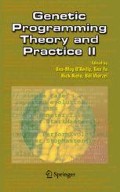Abstract
We applied genetic programming with a lambda abstraction module mechanism to learn technical trading rules based on S&P 500 index from 1982 to 2002. The results show strong evidence of excess returns over buy-and-hold after transaction cost. The discovered trading rules can be interpreted easily; each rule uses a combination of one to four widely used technical indicators to make trading decisions. The consensus among these trading rules is high. For the majority of the testing period, 80% of the trading rules give the same decision. These rules also give high transaction frequency. Regardless of the stock market climate, they are able to identify opportunities to make profitable trades and out-perform buy-and-hold.
Access this chapter
Tax calculation will be finalised at checkout
Purchases are for personal use only
Preview
Unable to display preview. Download preview PDF.
References
Allen, Franklin and Karjalainen, Risto (1999). Using genetic algorithms to find technical trading rules. Journal of Financial Economics, 51(2):245–271.
Bhattacharyya, Siddhartha, Pictet, Olivier V., and Zumbach, Gilles (2002). Knowledge-intensive genetic discovery in foreign exchange markets. IEEE Transactions on Evolutionary Computation, 6(2):169–181.
Brock, William, Lakonishok, Josef, and LeBaron, Blake (1992). Simple technical trading rules and the stochastic properties of stock returns. Journal of Finance, 47(5): 1731–1764.
Church, Alonzo (1941). The Calculi of Lambda Conversion. Princeton University Press.
Cooper, Michael (1999). Filter rules based on price and volume in individual security overreaction. The Review of Financial Studies, 12(4): 901–935.
Kaboudan, Mak (2002). Gp forecasts of stock prices for profitable trading. In Evolutionary Computation in Economics and Finance, pages 359–382. Physica-Verlag.
Koza, John R. (1992). Genetic Programming: On the Programming of Computers by Means of Natural Selection. MIT Press, Cambridge, MA, USA.
Koza, John R. (1994). Genetic Programming II: Automatic Discovery of Reusable Programs. MIT Press, Cambridge Massachusetts.
Neely, Christopher J., Weller, Paul A., and Dittmar, Rob (1997). Is technical analysis in the foreign exchange market profitable? A genetic programming approach. The Journal of Financial and Quantitative Analysis, 32(4):405–426.
O’Neill, Michael, Brabazon, Anthony, and Ryan, Conor (2002). Forecasting market indices using evolutionary automatic programming. In Genetic Algoritms and Genetic Programming in Computational Finance, pages 175–195. Kluwer Academic Publishers.
Pereira, Robert (2002). Forecasting ability but no profitability: An empirical evaluation of genetic algorithm-optimised technical trading rules. In Evolutionary Computation in Economics and Finance, pages 275–295. Physica-Verlag.
Pesaran, M. Hashem and Timmermann, Allan (1995). Predictability of stock returns: Robustness and economic significance. Journal of Finance, 50:1201–1228.
Pring, Martin J. (1991). Technical Analysis Explained. McGraw-Hill Trade.
Wang, Jun (2000). Trading and hedging in s&p 500 spot and futures markets using genetic programming. The Journal of Futures Markets, 20(10):911–942.
Yu, Gwoing Tina (1999). An Analysis of the Impact of Functional Programming Techniques on Genetic Programming. PhD thesis, University College, London, Gower Street, London, WC1E 6BT.
Yu, Tina (2001). Hierachical processing for evolving recursive and modular programs using higher order functions and lambda abstractions. Genetic Programming and Evolvable Machines, 2(4): 345–380.
Yu, Tina, Chen, Shu-Heng, and Kuo, Tzu-Wen (2004). A genetic programming approach to model international short-term capital flow. To appear in a special issue of Advances in Econometrics.
Author information
Authors and Affiliations
Editor information
Editors and Affiliations
Rights and permissions
Copyright information
© 2005 Springer Science+Business Media, Inc.
About this chapter
Cite this chapter
Yu, T., Chen, SH., Kuo, TW. (2005). Discovering Financial Technical Trading Rules Using Genetic Programming with Lambda Abstraction. In: O’Reilly, UM., Yu, T., Riolo, R., Worzel, B. (eds) Genetic Programming Theory and Practice II. Genetic Programming, vol 8. Springer, Boston, MA. https://doi.org/10.1007/0-387-23254-0_2
Download citation
DOI: https://doi.org/10.1007/0-387-23254-0_2
Publisher Name: Springer, Boston, MA
Print ISBN: 978-0-387-23253-9
Online ISBN: 978-0-387-23254-6
eBook Packages: Computer ScienceComputer Science (R0)

